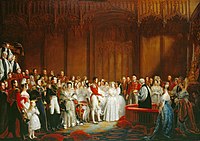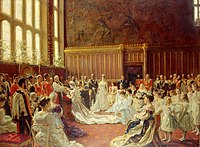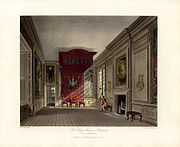St James's Palace
| St James's Palace | |
|---|---|
 The north gatehouse, main entrance of St James's Palace in Pall Mall | |
 | |
| General information | |
| Architectural style | Tudor |
| Location | London, United Kingdom |
| Coordinates | 51°30′17″N 00°08′16″W / 51.50472°N 0.13778°W |
| Construction started | 1531 |
| Completed | 1536 |
| Client | Henry VIII |
| Owner | King Charles III in right of the Crown |
St James's Palace is the most senior royal palace in London, the capital of the United Kingdom. The palace gives its name to the Court of St James's, which is the monarch's royal court, and is located in the City of Westminster in London. Although no longer the principal residence of the monarch, it is the ceremonial meeting place of the Accession Council, the office of the Marshal of the Diplomatic Corps, and the London residence of several members of the royal family.
Built by order of King
The palace now houses a number of offices, official societies and collections, and all ambassadors and high commissioners to the United Kingdom are still accredited to the Court of St James's. The palace's Chapel Royal is still used for functions of the British royal family. Official receptions are also regularly hosted at the palace.
The palace was mainly built between 1531 and 1536 in
History
Tudors
The palace was commissioned by
The palace was remodelled in 1544, with ceilings painted by
Stuarts

Prince Henry, Prince of Wales, the eldest son of King James and Anne of Denmark, lived at St James's Palace until his death in 1612. The gardens were improved for him by Alphonsus Fowle.[8] A riding school, one of the first in England, was built for Henry at St James's Palace between 1607 and 1609, and then a library with sculptural decoration by Maximilian Colt. Henry also installed a menagerie with pet birds including a pair of ostriches.[9]
In 1638, Charles I gave the palace to
The palace was restored by Charles II following the demise of the Commonwealth, landscaping
Hanoverians


The first two monarchs of the House of Hanover used St James's Palace as their principal London residence. George I and George II both housed their mistresses, the Duchess of Kendal and the Countess of Suffolk respectively, at the palace.[1] In 1757, George II donated the Palace library to the British Museum;[11] this gift was the first part of what later became the Royal Collection.[12]
20th century
In 1912–1913 the palace was the venue for the international conference that arranged the
Proclamation Gallery

The Proclamation Gallery is a part of St James's Palace, and it is used after the death of a reigning monarch. The
Today

St James's Palace is still a working palace, and the Royal Court is still formally based there, despite the monarch residing elsewhere. It is also the London residence of
The nearby Queen's Chapel, built by Inigo Jones, although since the 19th century across Marlborough Road, is still considered part of the Palace. While the Queen's Chapel is open to the public at selected times, the Chapel Royal in the palace is not accessible to the public. They both remain active places of worship.[22]
The offices of the
On 1 June 2007, the palace, Clarence House and other buildings within its curtilage (other than public pavement on Marlborough Road) were designated as a protected site for the purposes of Section 128 of the Serious Organised Crime and Police Act 2005, making it a specific criminal offence for a person to trespass into the site.[24]
See also
- Court of St James's
- Other official royal residences in London:
- Palace of Westminster – The principal residence of the English kings from 1049 until 1530
- Palace of Whitehall – The principal residence of the English kings from 1530 until 1689
- Kensington Palace – A principal residence of English and later British monarchs between 1689 and 1760
- Bushy House – future William IV took up residence here in 1797 when appointed Ranger of Bushy Park, and remained through his reign as king (1830–1837) rather than St James's or (later) Buckingham
- Buckingham Palace – The principal royal residence since 1837
Notes
- James the Just, brother of Jesus, was referred to as Bishop of Jerusalem, not James the Less.[1]
References
- ^ a b c d e f Walford, Edward (1878). "St James's Palace". Old and New London: Volume 4. Institute of Historical Research. Archived from the original on 18 October 2014. Retrieved 10 October 2014.
- ^ "St James's Park: Landscape History". The Royal Parks. Retrieved 11 July 2023.
- ^ ISBN 978-1-5988-4298-2. Archivedfrom the original on 8 April 2023. Retrieved 23 October 2022.
- ^ Walford, Edward (1878). "Chapter IX: St James's Palace" Archived 21 October 2014 at the Wayback Machine. Old and New London. London: Cassell, Petter & Galpin. Via British History Online. Accessed 9 September 2022.
- ^ ISBN 978-0-8511-5633-0.
- ^ "St James's Palace: History". The British Monarchy. n.d. Archived from the original on 9 March 2009. Retrieved 10 October 2014.
- ISBN 978-1-1080-2807-3.
- ^ Shepperd, Edgar (1894). "Memorials of St. James's Palace". Vol. 1 London: Longmans Green. pp. 66-7. (registration required)
- ISBN 978-0-5000-1375-5. Archivedfrom the original on 8 April 2023. Retrieved 23 October 2022.
- ^ Miller, 1
- ^ Warner, George (1912). Queen Mary's Psalter Miniatures and Drawings by an English Artist of the 14th Century Reproduced from Royal Ms. 2 B. Vii in the British Museum (PDF). London: Britism Museum. p. n. Archived from the original (PDF) on 23 May 2020. Retrieved 24 May 2011.
- ^ "Books and Manuscripts". Royal Collection. Archived from the original on 14 April 2011. Retrieved 24 May 2011.
- ISBN 978-0-3540-4529-2.
- ^ "Royal Residences: St James's Palace". The Royal Family. 23 November 2015. Archived from the original on 1 October 2022. Retrieved 23 April 2019.
- ^ Bulo, Kate (9 January 2018). "St. James' Palace: Henry VIII knocked down a hospital for women with leprosy to build another royal residence". The Vintage News. Archived from the original on 16 April 2019. Retrieved 9 September 2022.
- ISBN 978-0-3001-4238-9.
- ^ a b c A Pictorial and Descriptive Guide to London. London: Ward, Lock & Co Ltd. 1928. p. 108.
- ^ "1941: The Declaration of St. James' Palace". United Nations. Archived from the original on 25 February 2021. Retrieved 28 March 2016.
- ISBN 978-0-7704-3220-1.
- ISBN 978-0-4700-5931-9.
- ^ "St James's Palace window removed to let King Charles proclamation ring out from balcony". The Daily Telegraph. London. 10 September 2022. Archived from the original on 20 September 2022. Retrieved 16 September 2022 – via MSN.
- ^ a b c "St James's Palace: Today". The British Monarchy. n.d. Archived from the original on 9 March 2009. Retrieved 10 October 2014.
- ^ Perry, Simon (1 May 2018). "Princess Eugenie and Her Fiancé Jack Brooksbank Just Moved Next Door to Harry and Meghan!". People. Archived from the original on 18 February 2020. Retrieved 2 May 2018.
- ^ "Home Office Circular 018 / 2007 (Trespass on protected sites - sections 128–131 of the Serious Organised Crime and Police Act 2005)". Home Office. 22 May 2007. Archived from the original on 17 October 2017. Retrieved 18 July 2017.
Additional reading
- Wolf Burchard, 'St James's Palace: George II and Queen Caroline's Principal London Residence', The Court Historian (2011), pp. 177–203.
- Nikolaus Pevsner, The Buildings of England: London 6: Westminster (2003), pp 594–601




